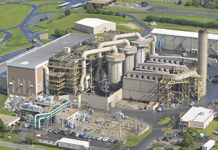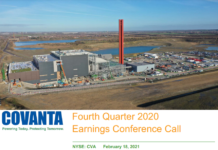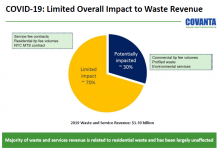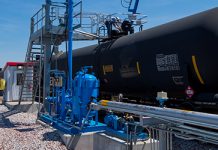Debra Fiakas, CFA
 |
| The Waste Hierarchy, with energy from waste highlighted |
Covanta Energy (CVA: NYSE) is a champion of renewable energy. So much so that Covanta commissioned an elaborate sustainability report in 2010, detailing the company’s three-year track record in elevating municipal waste from the landfill to a higher order of use. Compliant with standards set by the Global Reporting Initiative, the report is full of choice tidbits from Covanta’s municipal waste experience – at least through the year 2009.
Let’s look at 2009, the last year covered in Covanta’s sustainability report. Covanta says it takes about an hour to process one ton of municipal waste – the paper, cans, plastic grocery sacks, left over Chinese takeout and soda pop cans we toss in the garbage each day. The waste goes through a high heat process – it is not incineration – leaving an ash heap about one-tenth of the volume of the original waste. In 2009, Covanta processed 17 million tons of waste leaving behind 1.7 million tons of ash.
What is important about Covanta waste process is not so much the dramatic reduction in what goes into landfills. The heat is used to drive steam turbines that are part of a power plant. In 2009, Covanta’s operations generated 8.8 million megawatt hours of electricity. The process also allows for the recovery of metals – 400,000 tons in 2009.
The “what goes in and what comes out” presentation is straightforward enough. Covanta’s claims related to greenhouse gas emission reduction are a bit more complicated. Covanta’s sustainability report claims a reduction of 17.0 million tons of greenhouse gases in 2009, measured through an estimation of how much methane might have been generated by the waste going directly to the landfill, the net gain in electricity and the metals recovered.
I will give Covanta the benefit of the doubt on the greenhouse gas reduction. Of greater concern in my view is how much energy and resources are needed to sustain Covanta’s operations. The company does not avoid the question, but does not really answer the question either. Covanta’s plants do require some energy input during start-up, such as natural gas, fuel oil or propane. However, once the high heat process begins, it is self-sustaining. The plants only go off-line when needed for repairs or periodic maintenance. That is encouraging, but we are left guessing just how encouraging, as Covanta report does not disclose its consumption of any of these fossil fuels.
It is also important to note that the basic Covanta plant design requires about 0.7 acres for each megawatt hour of electricity that the plant is intended to produce. This is considerably less than is required for wind towers or solar farms.
Of course, whenever there is high heat, there is often also a significant water requirement. In 2009, Covanta used 560,000 gallons of water to process the 17 million tons of waste. It seems like a great deal of water. Fortunately the Covanta process does not require potable water. The 2009, water requirement was fulfilled with 400,000 gallons of grey water and another 160,000 gallons of landfill leachate water.
Covanta’s 2010 sustainability report is an impressive tome, but appears to be a one-time effort. The company has not published on update, leaving us wondering how sustainable Covanta’s operations have been in the last two and a half years. I do not think we should assume that the track record in 2010 and 2011 is exactly the same as 2009, but it is probably close. Covanta’s 2011 annual report claims 19.0 million tons of waste were processed and 10.0 million megawatt hours of electricity were generated.
One of the most interesting admissions in Covanta’s sustainability report is that the company’s own advisory group has questioned the wisdom of diverting waste to energy generation. There is apparently concern that Covanta’s minimum volume contracts with municipalities discourage recycling, which could be an even higher use for the waste than electricity generation.
The company’s experience suggests that one ton of waste can be used to generate 0.55 megawatt hours of electricity and 0.024 tons of recovered metals. However, if towns and cities promoted recycling then even more metals and other materials could be recovered. More importantly, communities should do more to encourage reuse and reduction in waste in the first place.
Covanta claims that you and me along with our fellow Americans generate about 390 million tons of waste annually. The U.S. Environmental Protection Agency estimated municipal waste was 250 million tons in 2010, significantly lower than Covanta numbers. According to Covanta about 69% of the waste is going to landfills. Another 24% is recycled. Covanta claims it has only got a lock on about 7% of municipal waste in the U.S. and wants to capture. The EPA thinks recycling rates are higher – around 34%. No matter which set of numbers you believe, it is clear we are an improvident bunch. Those advisors’ objections notwithstanding, it seems Covanta is doing us a big favor by elevating our garbage out of the landfill and onto bigger and better things.
This article is part II of a three part series. Part I is here.
Neither the author of the Small Cap Strategist web log, Crystal Equity Research nor its affiliates have a beneficial interest in the companies mentioned herein. CVA is included in Crystal Equity Research’s Beach Boys Index in the Waste-to-Energy Group.
Debra Fiakas, CFA is the Managing Director of Crystal Equity Research, an alternative research resource on small capitalization companies in selected industries.







